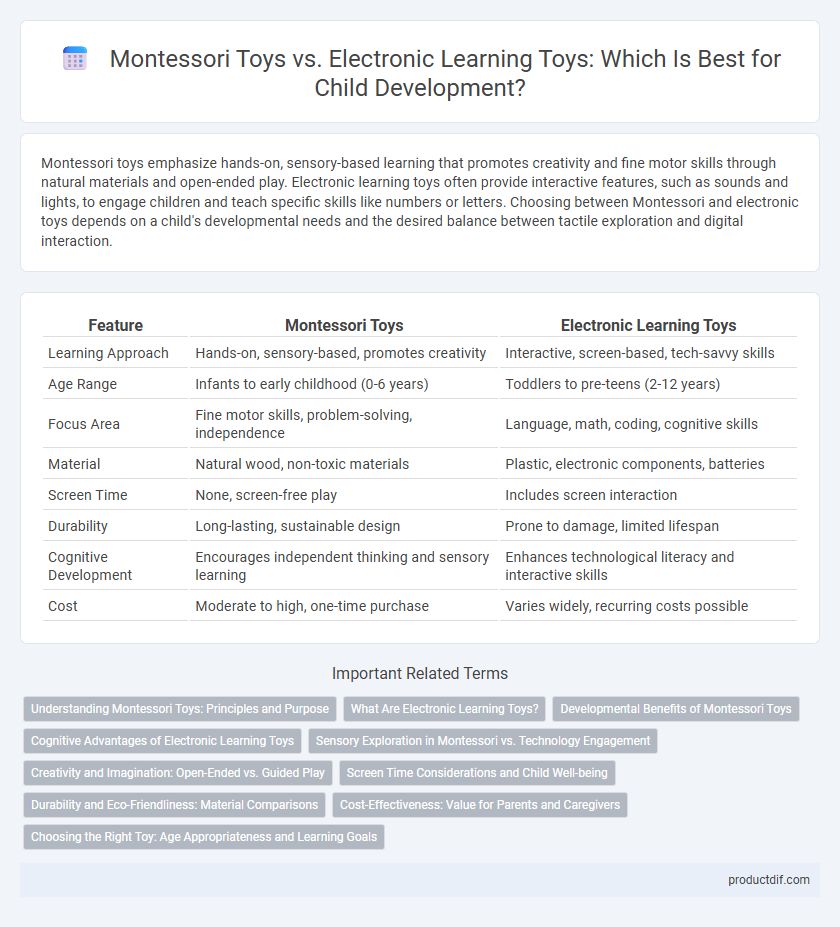Montessori toys emphasize hands-on, sensory-based learning that promotes creativity and fine motor skills through natural materials and open-ended play. Electronic learning toys often provide interactive features, such as sounds and lights, to engage children and teach specific skills like numbers or letters. Choosing between Montessori and electronic toys depends on a child's developmental needs and the desired balance between tactile exploration and digital interaction.
Table of Comparison
| Feature | Montessori Toys | Electronic Learning Toys |
|---|---|---|
| Learning Approach | Hands-on, sensory-based, promotes creativity | Interactive, screen-based, tech-savvy skills |
| Age Range | Infants to early childhood (0-6 years) | Toddlers to pre-teens (2-12 years) |
| Focus Area | Fine motor skills, problem-solving, independence | Language, math, coding, cognitive skills |
| Material | Natural wood, non-toxic materials | Plastic, electronic components, batteries |
| Screen Time | None, screen-free play | Includes screen interaction |
| Durability | Long-lasting, sustainable design | Prone to damage, limited lifespan |
| Cognitive Development | Encourages independent thinking and sensory learning | Enhances technological literacy and interactive skills |
| Cost | Moderate to high, one-time purchase | Varies widely, recurring costs possible |
Understanding Montessori Toys: Principles and Purpose
Montessori toys emphasize hands-on learning, fostering creativity, independence, and sensory development through natural materials and simple design. They are designed to support a child's self-directed exploration and focus on practical life skills rather than screen-based interaction. These toys encourage cognitive growth by promoting problem-solving and fine motor skills in a distraction-free environment.
What Are Electronic Learning Toys?
Electronic learning toys are interactive devices designed to enhance a child's educational experience through technology, offering features like touchscreens, audio prompts, and programmable activities that target skills such as problem-solving, language, and math. These toys often incorporate sensors and multimedia elements to provide immediate feedback and adapt to a child's learning pace, supporting cognitive development in an engaging way. Popular examples include tablets designed for kids, electronic storybooks, and STEM-focused gadgets that combine play with structured educational content.
Developmental Benefits of Montessori Toys
Montessori toys promote fine motor skills, creativity, and spatial awareness through hands-on, sensory-rich activities designed to encourage independent learning and critical thinking. These toys foster natural cognitive development by engaging children in problem-solving and exploration without the distraction of electronic stimuli. Their emphasis on real-world materials and open-ended play supports emotional regulation and social skills, setting a strong foundation for lifelong learning.
Cognitive Advantages of Electronic Learning Toys
Electronic learning toys enhance cognitive development by incorporating interactive features such as touchscreens, voice recognition, and adaptive feedback, which actively engage multiple senses and promote problem-solving skills. These toys often include programmable challenges that adjust to a child's learning pace, fostering critical thinking and memory retention more effectively than static Montessori toys. Their integration of technology supports early digital literacy, preparing children for a tech-centric environment while strengthening executive functions like attention and working memory.
Sensory Exploration in Montessori vs. Technology Engagement
Montessori toys emphasize sensory exploration through hands-on activities that develop tactile, visual, and auditory senses, fostering fine motor skills and cognitive growth. In contrast, electronic learning toys prioritize technology engagement by using interactive screens, sounds, and lights to capture children's attention and teach concepts through digital interfaces. This difference highlights Montessori's focus on natural sensory development versus electronic toys' reliance on technological stimulation for learning.
Creativity and Imagination: Open-Ended vs. Guided Play
Montessori toys promote creativity and imagination through open-ended play, encouraging children to explore materials and ideas independently without predefined outcomes. Electronic learning toys offer guided play with structured activities and feedback, often limiting imaginative freedom by directing focus on specific skills. Research shows open-ended toys enhance problem-solving and inventive thinking more effectively than strictly programmed electronic counterparts.
Screen Time Considerations and Child Well-being
Montessori toys emphasize hands-on, tactile learning that supports fine motor skills and cognitive development without involving screen exposure, thereby promoting healthier sleep patterns and reducing eye strain in children. Electronic learning toys, while interactive and engaging, increase screen time which can contribute to attention difficulties and overstimulation in young learners. Prioritizing Montessori toys helps align with pediatric recommendations for limited screen time to enhance child well-being and holistic growth.
Durability and Eco-Friendliness: Material Comparisons
Montessori toys, typically crafted from natural wood and organic materials, offer superior durability and biodegradability compared to electronic learning toys made from plastic and electronic components that often contribute to e-waste. The use of non-toxic finishes and sustainably sourced wood in Montessori toys ensures a lower environmental impact and longer lifespan, promoting eco-friendliness and safety. In contrast, electronic toys frequently require batteries and complex circuits, resulting in higher environmental costs and shorter usability periods due to technological obsolescence.
Cost-Effectiveness: Value for Parents and Caregivers
Montessori toys offer lasting value due to their durable materials and timeless educational principles, often costing less over time compared to electronic learning toys, which may require frequent updates or replacements. Parents and caregivers find Montessori toys cost-effective because they support open-ended play and cognitive development without reliance on batteries or software subscriptions. Electronic learning toys tend to have higher upfront costs and potential ongoing expenses but provide interactive features that can engage children with multimedia content.
Choosing the Right Toy: Age Appropriateness and Learning Goals
Montessori toys promote hands-on, sensory-rich experiences that enhance fine motor skills and cognitive development, making them ideal for toddlers and preschoolers focused on self-directed learning. Electronic learning toys often incorporate interactive features like sounds and lights, which can engage children aged 3 and up in early literacy and numeracy skills but may limit imaginative play. Selecting the right toy depends on aligning age-appropriate developmental milestones with specific learning goals, prioritizing tactile exploration for younger children and structured educational content for older learners.
Montessori Toys vs Electronic Learning Toys Infographic

 productdif.com
productdif.com